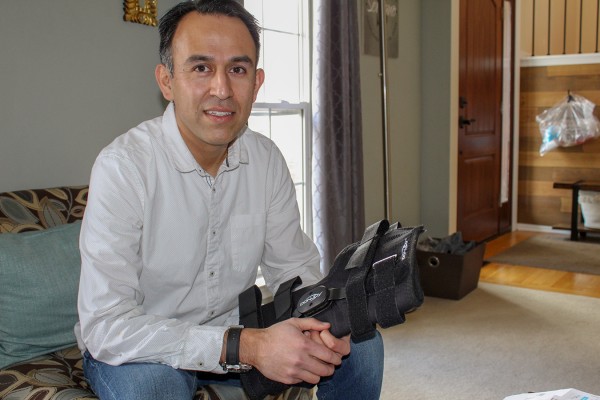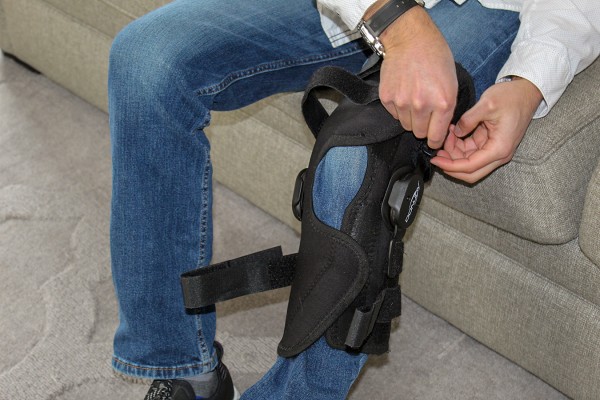
After a sports injury, Esteban Serrano owed $829.41 for a knee brace purchased with insurance through his doctor’s office. He says he found the same kind of braces selling for less than $250 online. (Paula Andalo/KHN)
Last October, Esteban Serrano wrenched his knee badly during his weekly soccer game with friends.
Serrano, a software engineer, grew up playing soccer in Quito, Ecuador, and he has kept up his sport since moving to the United States two decades ago.
He hobbled off the field and iced the knee. But the pain was so severe, he made an appointment with Rothman Orthopaedic Institute, a network of orthopedists practicing in Greater Philadelphia, New Jersey and New York.
The doctor diagnosed a strain of the medial collateral ligament, or MCL, and prescribed over-the-counter pain medication as well as a hinged knee brace, which he used for several weeks until he’d healed.
He expected his insurance to cover his treatment as a plan from a previous job had covered him when he needed surgery to fix a broken nose sustained in another soccer game in 2017.
Then the bill came.
Patient: Esteban Serrano, 41, a software engineer and father of two from Phoenixville, Pa., in suburban Philadelphia.

Total Bill: $1,197: $210 for the office outpatient visit, $105 for the X-ray and $882 for a hinged knee brace, all billed by the orthopedic practice. His insurer, Aetna, negotiated only $52.59 off the cost of the brace. That left Serrano with a balance of $829.41 because he hadn’t met his $3,000 deductible for the year.
Service Provider: Rothman Orthopaedic Institute in Bryn Mawr, Pa.
Medical Service: A doctor examined Serrano’s knee and sent him for an X-ray. The doctor said he should use a knee brace for four weeks and recommended a hinged one sold through the practice.
What Gives: An MCL injury is a common knee injury occurring frequently among participants in contact sports. According to the American Academy of Physical Medicine and Rehabilitation, the MCL is involved in at least 42 percent of knee ligament injuries. Although most cases are sports-related, such injuries can also result from everyday activities like tripping on stairs.
“The doctor told me that he thought I didn’t have damage, that it was more of an inflammation, but he ordered an MRI just to make sure,” said Serrano. (The MRI, at a later date, confirmed that suspicion.)
Serrano said the brace did ease the discomfort and stabilized his knee as it healed. However, the shocking bill was almost more painful — he owed the orthopedic practice $829.41.
“You can find the same brace for less than $250 online,” he said.
The bill came close to Christmas, when Serrano’s 12-year-old daughter wanted her first iPhone. “I told her ‘Sorry, honey, but I already paid a price of an iPhone for the hinged knee brace,’” Serrano joked.
Serrano emphasized that he felt lucky to have the money to handle a bill that for many people could equal a month’s rent or three months of groceries.
Knee braces fall into a category of products called “durable medical equipment,” whose prices can vary widely. Items range from slings and braces to wheelchairs and commodes to glucose meters and breast pumps for new mothers. Doctors and hospitals that dispense and prescribe such equipment for patients to take home almost always bill for them and add hefty markups that can catch patients unaware.
Braces and other products “are often marked up two or three times what the cost is, and unfortunately, that is the standard practice,” said Dr. Matthew Matava, an orthopedic surgeon and chief of sports medicine for Washington University Physicians in St. Louis.
Rothman Orthopaedic didn’t respond to requests for comments.
The type of hinged knee brace Serrano bought was a Donjoy Playmaker. Donjoy is one of the nation’s largest producers of braces. A customer service representative for the company said it charges a retail price of $242.51 for the model Serrano got. Serrano paid more than three times that price.

When Esteban Serrano injured his knee, his insurer, Aetna, covered the cost of his visit to an orthopedist and an X-ray, but only $52.59 of the cost of the brace. Serrano was left with a balance of $829.41.(Paula Andalo/KHN).
In an emailed statement about the case, an Aetna spokesman wrote that “while the cost of a knee brace, or any other health care service, is determined by the negotiated rate between the health care provider and the health plan, the starting point is the charge from the health care provider.”
It is not even clear that such an elaborate knee brace was needed for Serrano’s injury.
Dr. Elizabeth Matzkin, chief of Women’s Sports Medicine at Brigham and Women’s Hospital in Boston and an assistant professor at Harvard Medical School, said that while it is helpful to give patients some kind of knee brace for support after MCL injuries, the use of a hinged knee brace does not influence recovery, according to studies. She called hinged braces “luxury products.” Simpler, cheaper braces also offer support.
Resolution: Serrano recalled that when he received the brace, the practitioner showed him a form with its estimated cost in writing. He remembered his share was more than $700, but he didn’t pay too much attention because he assumed his insurance would cover it.
After receiving the bill, he made several phone calls to the doctor’s practice to get a copy of the form he’d signed. It stated that the product could be returned within seven days. A month had already passed. Because he had not met his deductible, his $829.41 balance was even more than the estimate.
The Takeaway: These days, many types of equipment dispensed by doctors’ offices or hospitals involve a charge. Don’t assume generosity. Ask the doctor to identify precisely what you need and explain why you need it.
When a doctor or hospital offers you a piece of equipment to help your healing, decide if you really need it or will use it. Say “no” if you will not. Ask if you will be billed for it and how much.
Many items can be purchased at a fraction of the cost online or from a pharmacy just down the block.
Know your insurance plan’s copay for medical equipment (often 20 percent). The cost of purchasing the equipment yourself online may well be less than the copay if you purchase through a medical office.
NPR produced and edited the interview with KHN Editor-in-Chief Elisabeth Rosenthal for broadcast.
Do you have an exorbitant or baffling medical bill? Join the KHN and NPR Bill-of-the-Month Club and tell us about your experience.













